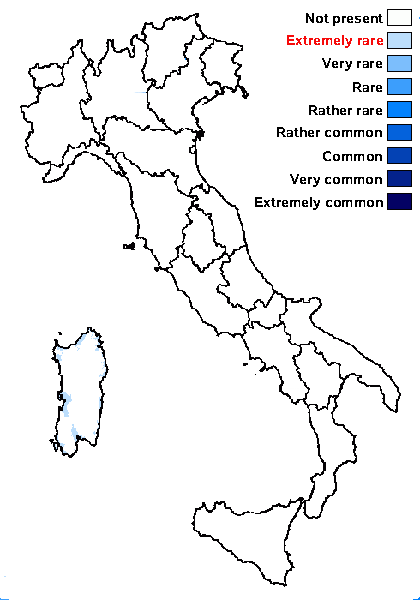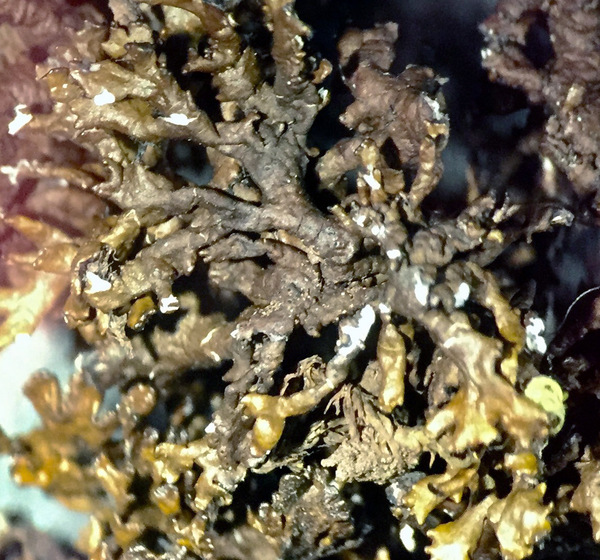Xanthoparmelia pokornyi (Körb.) O. Blanco, A. Crespo, Elix, D. Hawksw. & Lumbsch
Taxon, 53: 970, 2004. Basionym: Imbricaria pokornyi Körb. in Pokorny - Verh. zool.-bot. Ges. Wien, 10: 285, 1860.
Synonyms: Neofuscelia pokornyi (Körb.) Essl.; Parmelia pokornyi (Körb.) Szatala; Parmelia pulla var. pokornyi (Körb.) Türk & Breuss
Distribution: C - Sar (HAL-3087).
Description: Thallus foliose to apparently subfruticose, heteromerous, very loosely attached, consisting of ascending, often intricately tangled, forked, convex, 1-2(-3) mm wide lobes, usually not forming regular rosettes. Upper surface olive-brown to brown-black, glossy, weakly maculate at tips; lower surface black, usually canaliculate, with a few simple, black rhizines. Upper cortex brown, paraplectenchymatous, with a pored epicortex, the cell walls with Xanthoparmelia-type lichenan; medulla white. Apothecia rare, lecanorine, sessile to stipitate, to 5 mm across, with a brown disc and a smooth thalline margin. Epithecium brown; hymenium and hypothecium colourless. Asci 8-spored, thick-walled, the apex I+ blue with a wide, divergent axial body, Lecanora-type. Ascospores 1-celled, hyaline, ellipsoid, 8-11 x 4-7 µm. Pycnidia immersed. Conidia weakly dumbbell-shaped. Photobiont: chlorococcoid. Spot tests: cortex K-, C-, KC-, P-, N+ blue-green; medulla K-, C-, KC- -or C+ and KC+ pink to red, P-, UV-. Chemistry: medulla with stenosporic acid (major), divaricatic, perlatolic, demethylstenosporic, and oxostenosporic acids (minor/traces), sometimes with gyrophoric acid (major).Note: a mainly terricolous species of steppe-like habitats, closely related to X. pulla. The Italian sample was collected by B. Feige at Monte Linas.
Growth form: Foliose, broad lobed
Substrata: soil, terricolous mosses, and plant debris
Photobiont: green algae other than Trentepohlia
Reproductive strategy: mainly sexual
Commonnes-rarity: (info)
Alpine belt: absent
Subalpine belt: absent
Oromediterranean belt: absent
Montane belt: absent
Submediterranean belt: absent
Padanian area: absent
Humid submediterranean belt: absent
Humid mediterranean belt: extremely rare
Dry mediterranean belt: extremely rare

Predictive model
Growth form: Foliose, broad lobed
Substrata: soil, terricolous mosses, and plant debris
Photobiont: green algae other than Trentepohlia
Reproductive strategy: mainly sexual
Commonnes-rarity: (info)
Alpine belt: absent
Subalpine belt: absent
Oromediterranean belt: absent
Montane belt: absent
Submediterranean belt: absent
Padanian area: absent
Humid submediterranean belt: absent
Humid mediterranean belt: extremely rare
Dry mediterranean belt: extremely rare

Predictive model
 Index Fungorum
Index Fungorum
 GBIF
GBIF




